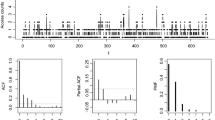Abstract
In this article, we discuss some geometric infinitely divisible (gid) random variables using the Laplace exponents which are Bernstein functions and study their properties. The distributional properties and limiting behavior of the probability densities of these gid random variables at \(0^{+}\) are studied. The autoregressive (AR) models with gid marginals are introduced. Further, the first order AR process is generalized to kth order AR process. We also provide the parameter estimation method based on conditional least square and method of moments for the introduced AR(1) process. We also apply the introduced AR(1) model with geometric inverse Gaussian marginals on the household energy usage data which provide a good fit as compared to normal AR(1) data.









Similar content being viewed by others
Data availability
No real world data is used for research described in this article.
Code availability
Not applicable.
References
Grunwald GK, Adrian ER, Guttorp P (1993) Time series of continuous proportions. Journal of Royal Statistical Society. Series B (Methodological) 55(1):103–116
Gaver D, Lewis P (1980) First-order autoregressive gamma sequences and point processes. Advances in Applied Probability 12–3:727–745
Dewald LS, Lewis PAW (1985) A new Laplace second-order autoregressive time series model. IEEE Transactions on Information Theory 31–5:645–651
Abraham B, Balakrishna N (1999) Inverse Gaussian autoregressive models. Journal of Time Series Analysis 20–6:605–618
Bhootna N, Kumar A (2022) Tempered stable autoregressive models. Communications in Statistics-Theory and Methods, 1–21
Lekshmi VS, Jose KK (2004) An autoregressive process with geometric \(\alpha -\) Laplace marginals. Statistical Papers 45:337–350
Lekshmi VS, Jose KK (2006) Autoregressive processes with Pakes and geometric Pakes generalized Linnik marginals. Statistics and Probability Letters 76:318–326
Grunwald G, Hyndman R, Tedesco L (1996) A unified view of linear ar(1) models. D.P. Monash University, Clayton
Kleinbaum GD, Klein M (2012) Survival Analysis: Self-Learning Text. Springer, New York, NY
Applebaum D (2009) Lévy Processes and Stochastic Calculus, 2nd edn. Cambridge University Press, Cambridge (UK)
Kumar A, Nane E (2018) On the infinite divisibility of distributions of some inverse subordinators. Modern Stochastic: Theory and Applications 5:509–519
Kumar A, Vellaisamy P (2015) Inverse tempered stable subordinators. Statistics and Probability Letters 103:134–141
Schilling RL, Song R, Vondracek Z (eds) (2012) Bernstein Functions: Theory and Applications. De Gruyter, Berlin, Boston
Klebanov BL, Maniya GM, Melamed IA (1985) A problem of Zolotarev and analogs of infinitely divisible and stable distributions in a scheme for summing a random number of random variables. Theory of Probability & Its Applications 29(4):791–794
Feller W (1971) An Introduction to Probability Theory and Its Applications. Wiley, New York
Ridout MS (2009) Generating random numbers from a distribution specified by its Laplace transform. Statistics and Computing 19(4):439–450
Schiff J (1999) The Laplace Transform: Theory and Applications. Springer, New York
Abramowitz M, Stegun IA (1954) Handbook of Mathematical Functions with Formulas, Graphs and Mathematical Tables. Conference on Mathematical Tables, Cambridge (UK)
Acknowledgements
Monika S. Dhull would like to thank the Ministry of Education (MoE), India for supporting her PhD research. Further, Arun Kumar would like to express his gratitude to Science and Engineering Research Board (SERB), India for financial support under the MATRICS research grant MTR/2019/000286.
Funding
Not applicable.
Author information
Authors and Affiliations
Contributions
All authors contributed equally.
Corresponding author
Ethics declarations
Conflict of interest
The authors declared that they have no conflict of interest.
Ethical approval
Not applicable.
Consent to participate
Not applicable.
Consent for publication
Not applicable.
Additional information
Publisher's Note
Springer Nature remains neutral with regard to jurisdictional claims in published maps and institutional affiliations.
Rights and permissions
Springer Nature or its licensor (e.g. a society or other partner) holds exclusive rights to this article under a publishing agreement with the author(s) or other rightsholder(s); author self-archiving of the accepted manuscript version of this article is solely governed by the terms of such publishing agreement and applicable law.
About this article
Cite this article
Dhull, M.S., Kumar, A. Geometric infinitely divisible autoregressive models. Stat Papers (2024). https://doi.org/10.1007/s00362-024-01564-y
Received:
Revised:
Published:
DOI: https://doi.org/10.1007/s00362-024-01564-y
Keywords
- Bernstein function
- Autoregressive model
- Geometric infinite divisibility
- Non-Gaussian time series modeling




